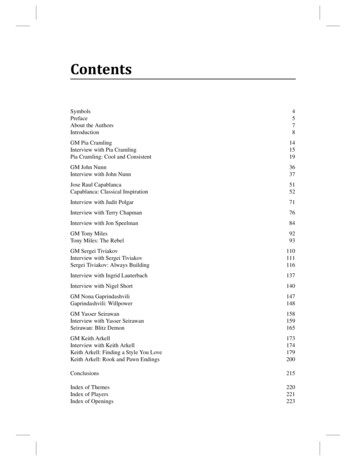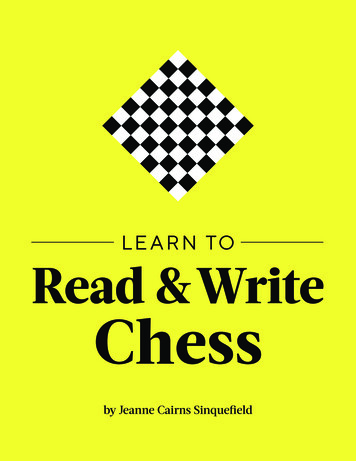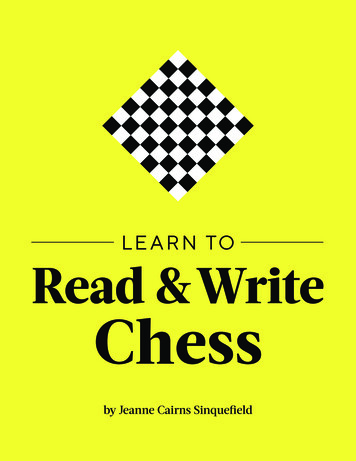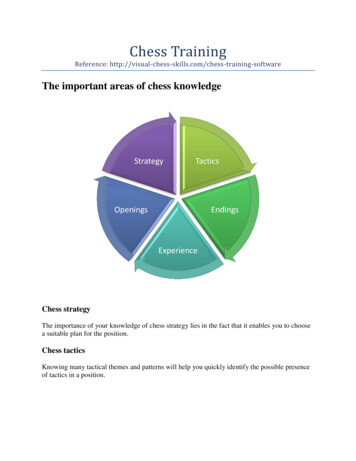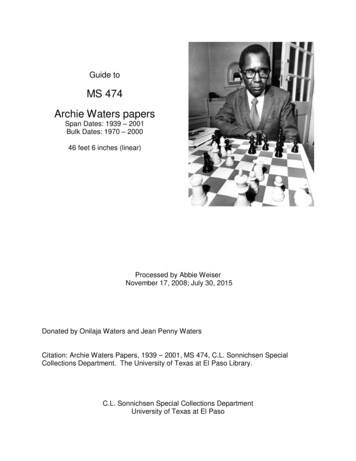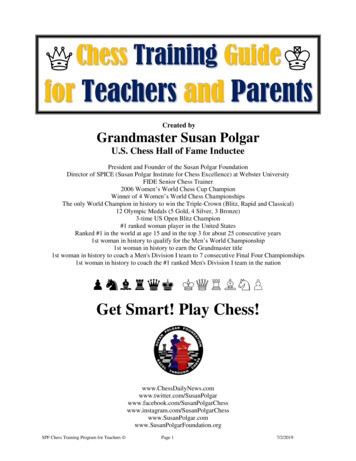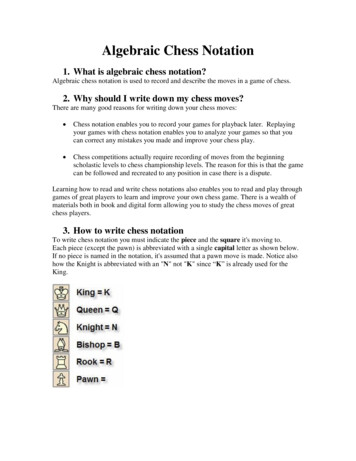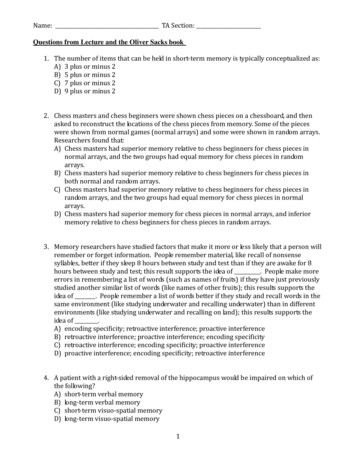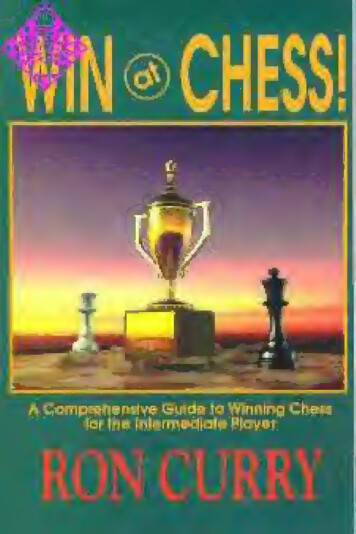
Transcription
Win at Chess!CONTENTSIntroduction.xiii1. CHESS GROWTH.1Chess Progression.22. CHESS NOTATION.7Special Symbols.7Definitions.7Files and Ranks.7Squares.8Diagonals.8Moves.8Captures.8Pawn Promotions.8Positions.8Annotation Symbols.9Part I — The Opening3. THE OPENING.11Goals in the Opening. 12Control the Center. 12Develop All Pieces. 13Safeguard the King. 14Hindrance. 15Opening Guidelines. 1512 Common Mistakes. 16A Look At The Openings. 18Strong Versus Weak Openings. 18Standard Openings. 18l.e4 . 19Giuoco Piano. 19Vienna Game . 19
Win at Chess!Ruy Lopez. 19King’s Gambit. 19Smith-Moira's Gambit. 19Gbring’s Gambit. 19l.d4. 20Queen’s Gambit Declined.20Queen’s Gambit Accepted.20Code’s Opening.20Curry’s Opening.20Blackmar-Diemer’s Gambit.201. c4 . 20English Opening.20Defenses.20To 1. c4. 20French Defense.20Caro-Kann’s Defense.20Center Counter Defense .20Sicilian (Najdorf) Defense.20Sicilian (Dragon) Defense.21Lire’s Defense.21To l.d4. 21Tarrasch’s Defense.21Tartakower’s Defense.21King’s Indian Defense.21Nimzo-Indian Defense.21Gruenfeld’s Defense.21Queen’s Indian Defense.21Dutch Defense.21Gambits.21Defending Against Gambits.21King’s Gambit Accepted.23King's Gambit Declined.23Smith-Morra’s Gambit Accepted.23Smith-Morra’s Gambit Declined.2 3Blackmar-Diemer’s Gambit Accepted.23Blackmar-Diemer’s Gambit Declined.23Falkbeer’s Countergambit.23Comparison of Openings.2 3
Win at Chess!Choosing Your Opening.25Learning a New Opening.26Recommended Openings and Defenses.274. THE CURRY OPENING.28Illustrative Games.29Comparisons.30Part II — The Middlegame5. THE MIDDLEGAME.31Goals in the Middlegame.32Five-Step Approach. 331. Analyze The Position. 34Seven Factors To Analyze.30King Safety.35Material Status.35Possible Tactics.36Piece Placement and Mobility. 36Pawn Structure.36Control of Important Squares.36Tempi.36Strengths and Weaknesses. 392. Detemnine Your Goals.41Strategy and Planning.41Tactical Vulnerability.42Positional Vulnerability.463. Define Your Tasks.474- Develop Candidate Moves.485. Select the Best Move.48Grading Moves.49“King of the Mountain”.50Four Key Questions.511. What Is The Threat?.522. What Has Changed?.543. Does This Move Improve My Position?. 574. Is This Move Safe?. 59“Your Move” Flow Chart.61
Win at Chess!Positional Play.62Outposts.63Pawn Play.65Simplifying.67Defense. Identifying The Threat.73Defensive Methods. 4Middlegame Guidelines.79Five Common Mistakes.80Exercise: Find The Best Move.82Exercise: Win All You Safely Can.84Practice Games.866. MIDDLEGAME TACTICS.90Major Tactics.90Superior Force.90Pin.91Skewer.92Knight Fork.92Double Attack.93Discovered Attack.93Minor Tactics.94Overworked Defender.94Vital Guards.94Removing Defenders.95Deflecting Defenders.95Sacrifices.95Back-rank Mate.96In-Between Move.97Interference .97No Retreat.98Trapped Pieces.98Desperado.99Zugzwang .99Queening Combinations.99Underpromotion. 100Move Sequence. 100Tactical Exercises. 101
Win at Chess!7. COMBINATIONS AND SACRIFICES. 104Combinations. 105Checkmate. 107Win Material. 108Expose and Restrict Enemy King. 109Prevent Castling. 109Gain Time for Development. 110Open Lines for Attack. 110Improve Mobility of Pieces. 111Simplify Into a Winning Endgame . 112Promote a Pawn. 112Avoid Checkmate. 113Minimize Material Loss. 11 3Gain Positional Advantage. 114Sacrifices. 114Gain Time for Development (Gambits). 115Open Lines for Attack. 115Improve Pawn Structure. 116Establish an Outpost. 116Unsound Combinations and Sacrifices. 117Combinations Exercises. 1208. ATTACKING THE KING.122Uncastled Enemy King. 126Kings Castled on the Same Side. 128Kings Castled on Opposite Sides. 1 32Attack Guidelines. 1 34Exercises on Attacking the King. 1359. CHECKMATE PATTERNS.140Queen and King. 141Queen and Rook. 141Queen and Bishop. 141Queen and Knight. 142Queen and Pawn. 142Queen. 142Rook and King. 143Rook anti Queen. 143
Win at Chess!Rook and Rook. I43Rook and Bishop. I44Rook and Knight. 144Rook and Pawn. I44Rook. I44Two Bishops and King. ]45Two Bishops and Knight. 14 5Bishop, Knight, and King. 145Knight and Bishop. 145Part III — The Endgame10. THE ENDGAME.I47Goals in the Endgame. 148Checkmate. 148King & Queen vs. King. 149King &. Rook vs. King. 150King & Two Rooks vs. King. 15 ]King &. Two Bishops vs. King. 151King, Bishop & Knight vs. King. 151Pawn Promotion. 152Principles. 1 52Queening Square. 153Opposition. 1 54Zugzwang. 157Triangulation. 157Pawn-Promotion Tactics. 158Passed Pawns. 1 58Sacrifices. 161Multiple Queening Threats. 163Offside Pawn Majority. 164Superior King Position. 166Restrict the Enemy King. 168Endgame Guidelines. 169Six Common Mistakes. 17011. ENDGAME TACTICS.172Offensive Tactics. 172
Win at Chess!Defensive Tactics. 177Endgame Tactical Exercises. 180Part IV — Practice & Progress12. ENDGAME PRACTICE.18413. STUDY LESSON GAMES.1901. Strong Center (Ruy Lopez). 1912. Premature Attack (Bishop’s Opening). 1933. Sacrifices (Curry Opening). 1954- Weaknesses (Tartakower Defense). 1975. Pawnstorm (King’s Indian Defense). 1996.Counterattack (Sicilian Defense).2027. Positional Play (English Opening).20514. SOLITAIRE CHESS.209Solitaire Game 1 (English Opening).210Solitaire Game 2 (Sicilian Defense).212Solitaire Game 3 (King's Gambit).215Solitaire Game 4 (Griinfeld Defense).216Solitaire Game 5 (Queen's Gambit).21615. CONTINUING YOUR IMPROVEMENT.219Study.219Intermediate Books.220Advanced Books.220Play.220APPENDIX A — CURRY-OPENING GAMES.2251. Orthodox Defense.2262. Queen’s Indian Defense.2263. King’s Indian Defense.2264. Gruenfeld Defense.2275. Irregular Defense.2276.Black Castles .0-0-0.2277. White Castles 0-0 .2288.Curry Opening Loses.228
Win at Chess!APPENDIX B — CONDENSED CHESS COURSE.229In General.229Offense.229Defense.2 0Bad Chess Habits.242Your Continued Development.244GLOSSARY.246EPILOGUE.252ABOUT THE AUTHOR.253WHAT OTHERS ARE SAYING.254COLOPHON258
Win at Chess!INTRODUCTIONChess, like love, like music, has the power to make men happy.— TarraschEvery chessplayer wants to play better chess and win more games. Toimprove, you will need to STUDY and PLAY chess — especially study. Tolearn to play better, an intermediate chessplayer needs information andguidance that is reliable, practical, clear, and well-organized. The comprehen sive, Master-proven principles and techniques in this book will improve yourchess game and help you progress toward chess mastery.The chessplayer who understands WHY will consistently defeat oppo nents who only know HOW! So, the focus of this book is on understandingimportant principles rather than memorizing lengthy sequences of moves. TheMasters’ key secrets of winning chess play are explained and illustrated withnumerous examples throughout this book, and the emphasis is on practicalwinning principles and methods. Essential principles of winning opening,middlegame, and endgame play are covered, as well as comprehensive tacticaland positional themes, maneuvers, and techniques. Numerous exercises areincluded to test your progress. Win At Chess! is a complete chess manual forimproving your chess game.The chess instruction in this manual is theoretically sound and practicallyreliable. All the principles and techniques have been proven effective by chessMasters in countless games over the centuries (and by the author, a chessExpert, in national and international tournament competition). During thepast twenty years, scores of the author’s students have successfully used theideas in this book to improve their chess games significantly. You can applythese winning principles and techniques in your games with confidence!Study, then apply these vital, Master-proven chess ideas, principles, andtechniques — and win at chess!Ronald H. CurryWilmington, DelawareMay 1995
Chess GrowthChapter 1CHESS GROWTHChess is a same of understanding, not memory.— Znosko-BorovskyDiagram 1Chess, the game of kings and king of games, is a game of skill and afascinating intellectual challenge. Chess is not simple; it is a complexgame founded on rules, guided hy rational thinking, and often influ enced by emotion. There are no axioms or unalterable laws governingevery chess position — precepts and guidelines can blaze a safe andpromising trail, hut you must ultimately select your own path to chessmastery.Chess requires and rewards logic, imagination, a competitive spirit,patience, and, above all, understanding. Learning and applying soundprinciples, rather than memorizing moves, is the key to success. Win ning chess games requires knowledge in the opening, imagination in themiddlegame, and technique in the endgame.In the soul of every chessplayer breathes the spirit of a Bobby Fischeror Gary Kasparov, but the bleak truth is that most chessplayers do notadvance beyond a low intermediate strength. The anchor retardingtheir progress is lack of knowledge — they seldom study.—1
Win at Chess!The secret to improving your chess is to combine STUDY withPLAY. Study alone is sterile; play alone is limiting (you tend to repeatand reinforce your mistakes). A note of caution: many experienced butrelatively weak chessplayers are prisoners of their pasts. Clinging to incorrect or incomplete old chess ideas, and shackled by vestigial notions andinadequate playing habits, they are reluctant to adopt new ideas, changetheir games for the better, and grow. Change and growth are essentialfor improvement in chess. No chessplayer improves without taking risks(“Behold the turtle, who makes no progress until he sticks his neckout.”). Changing established chessplaying patterns takes courage, patience, and time, but the rewards are worth the effort.This book is for the chessplayer who seriously wants to improve. Inreading this book you will probably encounter some new or differentideas on how to play better chess. For maximum benefit, set up each ofthe diagrammed positions on a chessboard for study. While the textexplains and summarizes, the diagrams clarify and reinforce importantprinciples and techniques. If you are unfamiliar with any of the chessterms used, consult the Qlossary.The chapters in this book are arranged in logical progression; but ifyou are impatient and anxious to improve yourchessgame immediately,read Appendix B ( The Condensed Chess Course”) for concise, com prehensive instruction. Ifone area of your chess game particularly needsimprovement, read the chapter on that topic.To become a complete chessplayer, however, be certain to read all thechapters to increase and balance your chess improvement. Do all thepractical exercises included in several chapters — they simulate gameconditions and afford you instructive practice in applying the principlesyou have learned.You WANT ro improve your chess, you CAN improve your chess,and you WILL improve your chess. Let’s get started!CHESS PROGRESSIONFirst, let us find out where you are on the ladder of chess and whatlies ahead for you.As you improve, you will grow through several distinct stages ofdevelopment. At each stage, a dominant theme may emerge for yourfocus and mastery before you can progress to the next level. Naturally,you retain and increase your proficiency with previous themes as you
Chess Growthcontinue your improvement.In reviewing my own chess career, I find a definite, typical, hierarchical pattern of development. Although many of the themes in chessdevelopment overlap strength levels, the pattern of progression is clear.You can assess your present status as an amateur chessplayer and learnwhat challenges await you by comparing your level of knowledge andskills with mine at various stages of development. My various chessstrengths are expressed as United States Chess Federation (USCF)national ratings.1000 — When my chess strength was approximately 1000 (lowintermediate), my play was characterized by careless openings, prema ture attacks, aimless moves and captures, inferior and passive defense,an impotent, embryonic endgame, and no sound ideas of purposefulpawn play. Worse yet, my major problem was losing material, because Ifrequently overlooked opponents’ one-move threats, even obviousones, and left my pieces en prise (attacked and unprotected). Oftenbefore 1 could begin to attack my opponent, he had already attacked meand won several pieces and pawns, or even checkmated me (soundfamiliar!). In fact, I was losing many chess games before I ever had achance to win. Before I could win at chess, I had to learn to avoid losing.The major culprit was overboking opponents’ threats. The effectiveremedy, which I did not know at the time, was simple: after each of myopponents’ moves I should have asked the vital question, “What is theTHREAT?” and before each of my moves I should have asked the keyquestion, “Is this move SAFE?” To win a chess game, you must first avoidlosing it!1200 — Having learned to sidestep some of my opponents’ threats,I could still win material only if my opponents left their pieces andpawns en prise or inadequately guarded. My attacks were obvious, andmostly unsuccessful. At this level I discovered the marvelous andintriguing world of TACTICS (pins, skewers, Knight forks, doubleattacks, discovered attacks, etc.). I learned the critical truth that chessgames are decided by tactics. Although I missed many (perhaps most)tactical opportunities in my games, I did occasionally manage to play aconvincing tactic if the conditions were pre-established. I also learnedthe useful method of counting the number and value of attackers and
Win at Chess!defenders, to determine the safety of captures and occupation of squaresby either side. My defense also improved, for I began to recognize morethreats and avoid many simple tactics by my opponents. I also learneda few standard opening moves and improved my inept endgame bystudying fundamental endgame techniques (“queening square,” oppo zugzwang). I learned the value — nay, necessity —each move with a specific purpose, and I started winning moresition, triangulation,of playinggames. Chess was becoming fun!1400— Buoyed up to 1400 by my newly acquired tactical skills, Idiscovered that peer chessplayers were far less obliging than weakeropponents in succumbing to my new expertise. I learned that againsttactics must he forced or induced. This illuminatingrealization exposed a fundamental weakness in my game — relying onopponents' errors — and led me to understand the essential truism thatevery successful chess tactic is based on one or more weaknesses in the position.strong chessplayers,Thus 1 discovered that the secret of playing effective tactics is torecognize — create (force or induce) if necessary — and ATTACKWEAKNESSES. To recognize weaknesses, I had to learn to analyzepositions more thoroughly forboth sides.This new skill of regularly and,sometimes, accurately analyzingeach position for weaknesses en abled me to pinpoint more tacticalThe Seven Basic FactorsWhich Characterize aChess Position Are:opportunities, and to defend betteragainst possible tactical threats bymy opponents. I also began playingmodest combinations and sacrifices,relying more on sound principles thanmemory. 1 was becoming achessplayer.1600 — Although I was win ning more often, my game was still1.2.3.4.King SafetyMaterialPossible TacticsPiece PLacement andMobility5. Pawn Structure6. Control of ImportantSquares7. Tempibased disproportionately on moveto-move threats and tactics. Mychess strategy could best be described as “get my pieces out, castle, andwait for my opponent to make a mistake.” Planning, if any, was4—
Chess Growthrudimentary and haphazard. Against 1600-strength peers, this strategyproved inadequate. My opponents were downright disobliging at mak ing tactical errors, and I was frequently stymied. In many middlegamepositions, I simply had no idea of what to do. At this plateau I soughtcounsel from several stronger chessplayers, read a chess book or two, anddiscovered the miraculous element of PLANNING. Planning, whileimportant and beneficial, was the most difficult theme I had encoun tered in my chess development. However, after considerable study andpractice (I enlisted stronger players to criticize my games, and started adiary of my losses to learn a pertinent lesson from each game), I wasfinally able to incorporate short- and long-term planning as an integralpart of my game and to liberate myself substantially from my formermyopic method of move-to-move chess. Soon I began winning moregames, even against stronger players, thanks to better planning.1800— At this level I began to appreciate seriously the role andvalue of POSITIONAL PLAY, especially the significance of pawnpawn structure alwaysinfluences — and sometimes dictates — strategy and tactics by defining thestructure and proper pawn play. I learned thatsquares and lines available for pieces. I learned that positional play,essentially the control of important offensive and defensive squares andlines, depends onactive piece placementandsound pawn formations.Ideveloped more skill at handling a variety of positions: open, semi-open,and closed. I reinforced and expanded my skill at avoiding and inflictingweak pawns (isolated, doubled, backward), and developed greaterawareness of “holes” in pawn structures (possible outposts) and offsidepawn majorities (potential new Queen). Extensive experience againststronger players convinced me that, while tactics always win chessgames, proper positional play is a necessary prelude to effective tactics.superior position is almost invariably a prerequisite for game-winningtactics. My games with peers were typically closer and longer, so I studiedAand improved my endgame knowledge and techniques (King role,distant opposition, pawn structure). To secure consistently promisingmiddlegames against stronger opponents, I also continued to broadenmy knowledge of openings. Further, I realized that the attacker winsmore often in chess, so I incorporated and emphasized more aggressiveplay, including active defense. I learned that there is a “thread” — aseries of related themes — running through most chess games, and it is—5
Win at Chess!important to hew to that thread. As a result, my play became morecoordinated, deeper, and longer-range — sounder.2000 — Improvement at this level has been more mental thantechnical: Being aggressive (always alert for weaknesses) More consistently evaluating positions correctly and analyzingvariations accurately Employing a systematic method of searching for moves Uniformly playing according to the offensive opportunities anddefensive necessities in each position Accurately applying more of my appropriate chess knowledge toeach position Evaluating plans more critically Being more flexible Being defensively tenacious and resourceful Mentally playingbothsides of the board at all times Carefully pacing myself (being patient) during each gameThese characteristics improved my chess. The solid, aggressive style ofplay I had developed earlier was further enhanced by understandingmore fully the importance of the INITIATIVE. With the initiative(ability to create threats), you control the game, direct the flow ofevents, and generally make your opponent “dance to your tune.”Painfully I discovered that when my opponents seized and maintainedthe initiative, I usually lost; when I developed a strong initiative, 1 oftenwon. The initiative is primarily achieved by gaining tempi and superiordevelopment, and it is frequently maintained by threats and hindrance.Like most chessplayers, I prefer to attack rather than defend, so concerntrating on seizing and maintaining theinitiativeis a current paramountconcern. I am still working at this level, plus reinforcing my knowledgeand skills learned at previous stages. Of course, I am looking forward tothe next level.This has been my progression in chess; it may or may not be yours— you may learn and apply some important chess themes and principlesbefore I did. You will encounter various personal stages of development.6—
Chess NotationChapter 2CHESS NOTATIONLanguage is mankind’s greatest invention.Chess moves and positions are usually recorded in modern Alge braic notation, which comprises a coordinated system to: 1) identifysquares on the chessboard, and 2) provide symbols describing moves andcaptures by the chessmen. The following symbols are used for n(omitted)&iHA* Special SymbolstCheck Double-check0-0Castles Kingside0-0-0Castles QueensideCheckmatePrecedes Black move (in text)DefinitionsFiles and Ranks(Note: The chessboard is always positioned so that each player hasalight square in his lower right-hand corner.) The eight vertical columnsof squares on the chessboard are FILES, designated a, b, c, d, e, f, g, and
Win at Chess!h, from White’sleft.The horizontal rows of squares are RANKS,numbered 1 to 8 from theWhiteside (Diagram 2):SquaresSquares are identified by their rank-and-file coordinates. In Dia gram 2, the white pawn is on the square c3, and the black pawn is on thesquare g6; the white Rooks are on el and e7, and the black Knights areon a5 and c5. (The square al is always in White’s lower left corner.)DiagonalsDiagonals are designated by their terminal squares (e.g., al-h8, fl-MovesMoves are described by specifying the letter for the piece moved (noletter is used for pawns) followed by its arrival square. N/3 describes aKnight move to the square f3, whilee5describes a pawn move to thesquare e5. Rank-and-file modifiers are used to prevent ambiguity. InDiagram 2, for example, both white Rooks are capable of moving to e5;therefore,Rle5specifies the Rook on thefirstrank moving to e5.Similarly, if the black N/a5 moved to b3, this move would be written.Nab3.Game moves are recorded using the move number, White’s move,then Black s move (e.g., 1.e4 N/6). Individual Black moves in text are.Bg4) to distinguish them from Whitepreceded by ellipses “.” (e.g., .moves.8—
Chess NotationCapturesCaptures are indicated by the symbol for the capturing piece (filedesignations are used for pawns) followed by an “x” and the designationsquare on which the captureof thetakes place.captured a chessman on the square c4;exd.5Bxc4indicates a Bishopindicates a pawn on the e-file captured a chessman on the square d5. Rank-and-file modifiers areused if necessary to prevent ambiguity (e.g.,Naxb3orRIxe5).Pawn PromotionsPawn promotions in this book are indicated by an equal sign “ ”(e.g., /8 Q indicates that a pawn advanced to the square f8 and“promoted” to a Queen;exf8 Nfindicates that a pawn on the e-filecaptured a piece on the square f8 and “underpromoted” to a Knightgiving check).PositionsThe position in Diagram 2 can he recorded as: White — R/e7, R/e 1,P/c.3; Black — N/a5, N/c5, P/g6.Annotation SymbolsThe following supplementary symbols are frequently used by anno tators to comment tersely on the quality of chess moves:!Strong move!!Outstanding move?Weak moveV.Blunder!?Sharp move, but risky?!Trappy move, but unsoundThese symbols merely reflect the annotator’s opinion.For experience with Algebraic notation, play through the d46.0-0cxb2—9
Win at Qxc4Be 518.RfelBb619.exd6tKf820.Re7Qc 621.Nxh7tBxh722.Qxf7#SummaryAlgebraic notation is simple, accurate, and concise. Easy to read andrecord, it is recommended for all chessplayers.10—
Part ITHE OPENING
Win at Chess!Chapter 3THE OPENINGA chess game begins on the first move!Goals in the OpeningIn the opening (first 10-15 moves), pieces and pawns are mobilizedfor arrack and defense. Checkmate is not a realistic prospect in theopening, barring suicidal blunders by your opponent, so the four primaryopening goals are: Control the center Develop all pieces Safeguard the King Hinder your opponentEach move in the opening should contribute toward one or more ofthese important goals; otherwise, the move is probably weak or anoutright mistake.The outcome of the opening determines or influences your strategicalternatives and tactical opportunities for many subsequent moves. Themajor objective in the opening is to build a safe, solid, active, andflexible position which will provide promising tactical and positionalopportunities in the middlegame. A well-played opening does not aimfor an immediate knockout; rather, the opening builds for the future.Let us examine these four goals in greater detail.Control the CenterIn the opening, it is very important to occupy and attack the centersquares (d4, d5, e4, e5) to gain space for your pieces and restrain enemypieces and pawns from occupying and controlling the center. Control ling the center allows you to post active, mobile pieces on strong centralsquares while denying your opponent similar desirable development.Achieving a strong, supported Ideal Pawn Center (two central pawns
The Openingsafely abreast on the fourth rank, protected by pieces — see Diagram 3)gains valuable central space, releases both your Bishops, and restrictsyour opponent’s access to important central squares, hindering hisdevelopment. A mobile Ideal Pawn Center can later advance to gainmore space for your pieces and cramp the opponent.An advanced pawn wedge in the center (pawns on d4 and e5, or d5and e4) also divides and restricts opposing pieces and pawns.Controlling the center squares is also important because Knightsand Bishops exert their maximum power in or near the center, and manyattacking lines crisscross through the center in the middlegame. Thecenter is the hub of the chessboard, and the side which controls thetraffic in the center controls the game. Try to gain and maintain controlof the center.Develop All PiecesEvery piece should be moved to its most effective and safe square inthe opening. Develop all your pieces in the opening; do not try to wagea chess war with half your forces sitting idly on their original squares.Seek effective, strong squares which allow your pieces the most scope,mobility, and aggressive prospects.Knights and Bishops belong near the center, attacking it (Bishopscan also control the center from the wings, by fianchettoed develop ment (i.e., Bishops on b2, g2, b7, org7) or by pinning opposing Knightswhich attack the center). Rooks belong on open files, or files likely tobecome open, especially central files. The Queen’s placement is flexible— develop the Queen, but not too early. The Queen is the most—13
Win at Chess!powerful piece, and will strongly influence the game; hut premature,aggressive attacks and pawn-grabbing expeditions with the Queen areusually abortive, and lose time and position when the powerful Queenis harassed by opposing minor pieces and pawns. A long-range piece, theQueen can function effectively close to home in the opening.Develop a new piece in preference to moving an already developedpiece twice; ideally, move each piece only once in the opening. (Theposition of each piece can be improved later, as circumstances change.)Moving the same pieces multiple times in the opening costs valuablemoves (tempi) which can usually be used to better advantage to developnew pieces. White tempi losses, in effect, reverse the colors in the gameand give Black the initiative. Black tempi losses are even more serious,as Black begins the game one move behind and falls even further behindin development. Avoid losing tempi in the opening.Safeguard the KingKing safety is paramount. Left on a central file, a King becomesvulnerable in the early middlegame when central lines begin to open.For that reason, both Kings are normally whisked to safety by castlingin the opening, before any middlegame activities (especially lineopenings and attacks) occur.Kingside castling is usually safer, since all pawns sheltering thecastled King are protected and no open lines lead directly to the King.Queenside castling is typically more aggressive but metre risky, since aRook is developed to a central file immediately but the a-pawn isunprotected, and an open diagonal (cl -h6 or h3-c8) often leads directlytoward the castled King. A recent survey of several hundred Grandmas ter games revealed that Grandmasters castle in over 90 percent of theirgames, and nine times out of ten on the Kingside.When should you castle? Castle when your King is endangered orwhen you do not have a better move, such as developing an importantpiece. Timing is important. Castling too soon informs your opponent ofyour King’s permanent address and allows him to direct his piecestoward that sensitive sector. Conversely, postponing castling too longis often dangerous because you may be attacked and lose castlingprivileges.Occasionally, especially when Queens and several minor pieceshave been exchanged early, a King is relatively safe in the middle — and14--
The Openingis closer to the center of action for the endgame — but such instancesare rare, and castling to safeguard your King should be a standard partof the opening. A safe King is a happy King. Castle!HindranceAlong with controlling the center, developing all pieces, andsafeguarding your King, an important fourth opening objective is tohinder your opponent from accomplishing the same goals. If a moveweakens your opponent’s position without harming yours, and preventsor hinders your opponent from realizing his opening objectives, themove is probably a sound idea and will gain a relative advantage(Diagram 4):Diagram 4-White to moveWhite has available the obvious move 9. Bg5, pinning the black N/f6 to the Queen, but chose instead 9. Ba3! to prevent Black fromcastling Kingside (a King cannot castle through check). Queensidecastling by Black could be dangerous because of the half-open b- and cfiles, which White could use later for attack. White’s strong 9. Ba3develops a new piece and hinders Black.In addition to the four basic principles covered above, you may findthe following important guidelines helpful to your opening play.Opening Guideline
Chess, like love, like music, has the power to make men happy. — Tarrasch . Every chessplayer wants to play better chess and win more games. To improve, you will need to STUDY and PLAY chess — especially study. To learn to play better, an intermediate chessplayer needs information and
